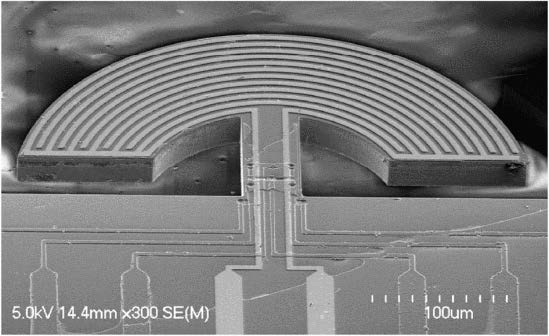Sensor selectivity is difficult without tailoring the chemistry
Across all classes of chemical microsensors, high sensitivity, low limit of detection, long-term stability, and high selectivity are desired. Of these properties, selectivity remains the most difficult to improve due to the tradeoff of the reversibility of analyte interaction with the sensing layer. Therefore, methods that enhance selectivity without tailoring the sensing layer chemistry are needed.
Measuring variations in transient response times discriminates between multiple volatile organic compounds (VOCs)
This tunable MEMs gas sensor improves performance in both selectivity (i.e., the ability to discern a target chemical within interfering molecules) and sensitivity (i.e., the ability to detect low concentrations of the target chemical) and only requires a software update to change target chemicals.
An improved gravimetric chemical sensor is overlayed with an interdigitated electrode (IDE) structure, enabling multivariate sensing using a single polymeric film. The single micromachined multivariate gas sensor with multiple outputs discriminates between multiple VOCs by utilizing variations in the transient response times of the gravimetric and impedimetric responses. Using comparisons of transient response in 2D dispersion in addition to the steady-state response showed enhanced discriminatory ability versus steady-state response alone. Simultaneously examining the respective capacitance and mass measurements during the transient response time of the sensor improves performance within a 15-second window.
This innovation highlights the ability of certain multi-sensors to enhance selectivity, not only through use of the steady-state dispersions but also transient response time dispersions at no additional cost to the sensor designer, as only the software needs to be updated rather than the sensor itself. This work could pave the way for future selectivity enhancement mechanisms with drastically improved sensor response times, which is critical for monitoring VOCs in industrial environments and closed operational settings.
This approach also enables a low-cost embedded/wearable system that offers a wide variety of potential biological and chemical sensing applications.
- Enhanced selectivity: Combines gravimetric and impedimetric responses to demonstrate enhanced discrimination between multiple VOCs
- High sensitivity: Offers sub parts-per-million detection limits for VOCs
- Tunable: Software updates allow the sensor to identify different compounds without modifying the MEMS device itself
- Powerful: Enables the simultaneous observation of both mass loading and dielectric changes in polymeric sensing films upon sorption of an analyte
- Efficient: Leverages thickness of the polymer film as an additional mechanism to tune variation in multivariate responses
- Fast: The approach returns results within the initial transient response of the sensor, as opposed to waiting for the steady state.
- Small: Rather than using an array of sensing elements, this technology uses a single multiple output MEMS resonant gas sensor.
- Easy to manufacture: Uses batch-fabricated sensors compatible with commercial-off-the-shelf (COTS) electronics.
- Biomedical: Supports monitoring of respiration and unique diagnostic opportunities.
- Industrial: Supports safety requirements with respect to hazardous and explosive airborne chemical compounds.
- Automotive: Supports the monitoring of cabin air quality, fuel emission, and electric vehicle battery performance.

Figure 1. SEM image of gravimetric/impedimetric multisensor with hammerhead-shaped resonator and interdigitated electrode on top of a semicircular annulus
Figure 2. Illustration of Low-Cost Wearable Mass-Sensitive and Capacitive Bio/Chemical Multi-Sensor
